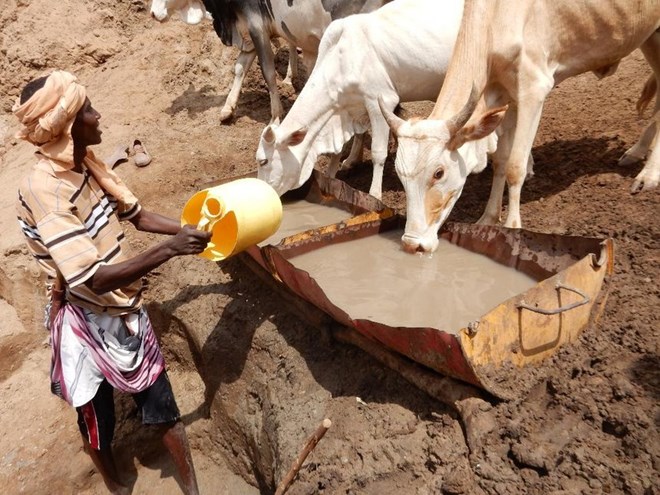
Outlook grim as FAO warns of worsening drought and hunger
By GILBERT KOECHKOECHJUNIOR_1
Friday, December 23, 2016

A pastoralist gives his cattle water fetched from a drying well in Tana River county on October 2 /ALPHONCE GARI
Kenya is among the Horn of Africa countries that are likely to see a rise in hunger and further decline of livelihoods in the coming months.
Farming families will be struggling with the knock-on effects of multiple droughts that hit the region this year, Food and Agriculture Organisation said in an early warning brief Tuesday.
It said close to 12 million people in Ethiopia, Kenya and Somalia are currently in need of food assistance. Families face limited access to food and income, together with rising debt, low cereal and seed stocks, and low milk and meat production.
“Terms of trade are particularly bad for livestock farmers, as food prices are increasing. At the same time, market prices for livestock are low,” Fao said.
It said the production outputs in the three countries are grim.
Fao warns that the growing number of refugees in East Africa will place even more burden on already strained food and nutrition security.
“Farmers in the region need urgent support to recover from consecutive lost harvests and to keep their breeding livestock healthy and productive at a time that pastures are the driest in years,” it said.
Fao director for emergency and rehabilitation Dominique Burgeon said, “We are dealing with a cyclical phenomenon in the Horn of Africa.”
“But we also know from experience that timely support to farming families can significantly boost their ability to withstand the impacts of these droughts and soften the blow to their livelihoods,” he said.
Burgeon said Fao has already started disbursing emergency funds for rapid interventions in Kenya and Somalia in response to the situation.
The funds will support emergency feed and vaccinations for breeding and weak animals, repair water points, provide seeds and tools to plant in the spring season.
Fao is also working with officials to bolster countries’ emergency preparedness across the region, targeting areas mostly hit by natural hazards.
Kenya is highly likely to see another drought in early 2017, and with it a rise in food insecurity.
Current estimates show 1.3 million people are food insecure, but the Kenya Red Cross estimates the number would hit 2.5 million.
Fao said the impacts of the current drought in the southern part of the country will lessen by mid-2017, but counties in the North – in particular Turkana, Marsabit, Wajir and Mandera – will steadily get worse.
“Families in these areas are heavily dependent on livestock. Now, with their livelihoods already stressed – the last reliable rain they received was in December 2015- they will get little relief from the October-December short rains, which typically mark a recovery period but once again fell short this season,”it said.
FAO says the terms of trade are unfavourable for livestock keepers, as prices of staple foods are rising, while a flood of weakened sheep, goats and cows onto local markets has brought down livestock prices.
To ensure livestock markets remain functional throughout the dry season in 2017, FAO, is training local officials in better managing livestock markets — in addition to providing feed, water and veterinary support.
FAO described the situation in Somalia as “grim” a matter made worse, by the country’s driest season expected to begin at Jilaal in January and is expected to be even harsher than usual.
Some five million Somalis are food insecure through December 2016.
This includes 1.1 million people in Crisis and Emergency conditions of food insecurity.
FAO said farming families in Ethiopia are extremely vulnerable as they have not been able to recover from the 2015 El Nino-induced drought.
Some 5.6 million people remain food insecure, while millions more depend on livestock herds that need to be protected and treated to improve milk and meat production. Here, too, better access to feed and water is critical.